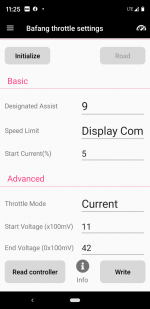geo, I'll post my settings for comparison, but they don't appear that different from yours.
My designated assist is at "9" like yours. My speed limit is different at "By Displays Command", but if I understand correctly the throttle overrides this anyway. My start current is different at "5". My throttle mode is the same at "Current". My start voltage is the same at "11". My end voltage is different at "42". My understanding here is that the OEM Bafang throttle communicates with the controller at 4.2V, hence the value of "42". I've read elsewhere that having less or different end voltage causes a jerky throttle. Example, supposedly some aftermarket throttles have different voltage communication values and have to be set in the program to communicate with the controller at that value or you get a jerky throttle. I recently bought and installed a Luna full grip throttle for my BBSHD. I thought I'd have to test the voltage and change my program, but when installed it was a seamless power delivery. Perhaps Luna has their throttle designed with the same voltage value as the OEM units. I went with the full grip throttle as I've been a dirt motor guy most of my life, and this throttle is more intuitive to my use. On that OEM throttle, mine looks like the one Chalo posted there, but "AFTER" programming it was quite smooth. Not sure if there are other differences in our systems that affect throttle. I would ask if you've tried the "42" setting on end voltage instead of "35", just to eliminate that.




